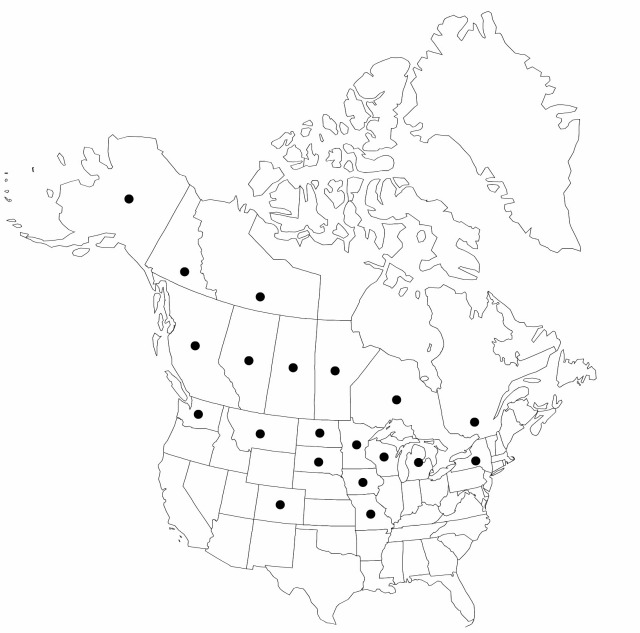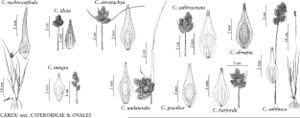Difference between revisions of "Carex sychnocephala"
Amer. J. Sci. Arts, ser. 2, 4: 24. 1847.
FNA>Volume Importer |
imported>Volume Importer |
||
| (6 intermediate revisions by 2 users not shown) | |||
| Line 8: | Line 8: | ||
}} | }} | ||
|common_names=Carex compact | |common_names=Carex compact | ||
| + | |special_status={{Treatment/ID/Special_status | ||
| + | |code=F | ||
| + | |label=Illustrated | ||
| + | }}{{Treatment/ID/Special_status | ||
| + | |code=E | ||
| + | |label=Endemic | ||
| + | }} | ||
|basionyms= | |basionyms= | ||
|synonyms= | |synonyms= | ||
| Line 24: | Line 31: | ||
|elevation=less than 1500 m | |elevation=less than 1500 m | ||
|distribution=Alta.;B.C.;Man.;N.W.T.;Ont.;Que.;Sask.;Yukon;Alaska;Colo.;Iowa;Mich.;Minn.;Mo.;Mont.;N.Y.;N.Dak.;S.Dak.;Wash.;Wis. | |distribution=Alta.;B.C.;Man.;N.W.T.;Ont.;Que.;Sask.;Yukon;Alaska;Colo.;Iowa;Mich.;Minn.;Mo.;Mont.;N.Y.;N.Dak.;S.Dak.;Wash.;Wis. | ||
| − | |discussion=<p>Because Carex sychnocephala often lacks conspicuous rhizomes and has a small diffuse root system, it may appear to be annual. In some situations, it may actually grow as an annual.</p> | + | |discussion=<p>Because <i>Carex sychnocephala</i> often lacks conspicuous rhizomes and has a small diffuse root system, it may appear to be annual. In some situations, it may actually grow as an annual.</p> |
|tables= | |tables= | ||
|references= | |references= | ||
| Line 33: | Line 40: | ||
-->{{#Taxon: | -->{{#Taxon: | ||
name=Carex sychnocephala | name=Carex sychnocephala | ||
| − | |||
|authority=J. Carey | |authority=J. Carey | ||
|rank=species | |rank=species | ||
| Line 47: | Line 53: | ||
|publication title=Amer. J. Sci. Arts, ser. | |publication title=Amer. J. Sci. Arts, ser. | ||
|publication year=1847 | |publication year=1847 | ||
| − | |special status= | + | |special status=Illustrated;Endemic |
| − | |source xml=https:// | + | |source xml=https://bitbucket.org/aafc-mbb/fna-data-curation/src/2e0870ddd59836b60bcf96646a41e87ea5a5943a/coarse_grained_fna_xml/V23/V23_593.xml |
|genus=Carex | |genus=Carex | ||
|section=Carex sect. Cyperoideae | |section=Carex sect. Cyperoideae | ||
Latest revision as of 20:41, 5 November 2020
Culms aphyllopodic, smoothly 3-angled, 8–40 cm. Leaves: sheath white-hyaline adaxially, summit U-shaped, smooth; distal ligule 0.5–4.3 mm; blades 0–3 per culm, 12 cm × 1.2–3 mm. Inflorescences green or pale brown, 1.6–3 cm × 7–15 mm; proximal internode (2–)4–8 mm, 2d internode 1.7–4 mm; bracts appressed to ascending. Spikes 3–8, densely clustered except, often, the proximal 1–2, obovoid-oblanceoloid, 10–16 × 5–7 mm, base acute to acuminate, apex truncate. Pistillate scales white- or gold-hyaline with green or gold midstripe, lanceolate to ovate, to 3.5–4.5 mm, shorter than or longer than perigynia. Perigynia appressed, green or gold to light brown, conspicuously 3–12-veined abaxially, 0–9-veined adaxially, wing 0.1–0.15(–0.2) mm wide, narrowly lanceolate, (4.6–)5.5–7.3 × 0.7–1.2 mm, 0.3–0.4 mm thick; beak tip white, green, or gold, narrowly flat, distance from beak tip to achene 3–5 mm, ± ciliate-serrulate. Achenes elliptic to ovate, 1–1.8 × 0.6–0.8 mm, 0.3–0.4 mm thick. 2n = 64.
Phenology: Fruiting summer–fall.
Habitat: Wet areas, at least seasonally, open, sandy, silty or peaty shores, banks, on limestone
Elevation: less than 1500 m
Distribution

Alta., B.C., Man., N.W.T., Ont., Que., Sask., Yukon, Alaska, Colo., Iowa, Mich., Minn., Mo., Mont., N.Y., N.Dak., S.Dak., Wash., Wis.
Discussion
Because Carex sychnocephala often lacks conspicuous rhizomes and has a small diffuse root system, it may appear to be annual. In some situations, it may actually grow as an annual.
Selected References
None.
